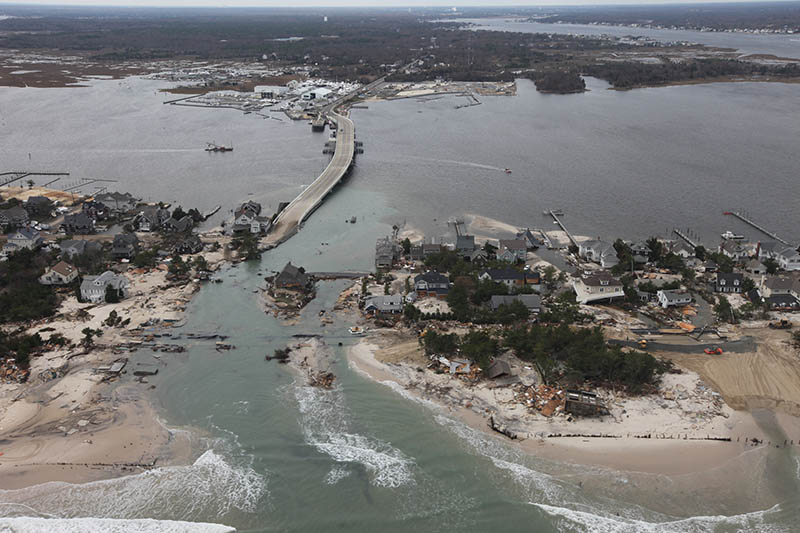The U.S. Army Corps of Engineers and contractor Weeks Marine have begun one of the nation’s biggest beach replenishment projects to date, a $128 million effort to pump 11 million cu. yds. of sand along 14 miles of New Jersey’s coastline.
That heavily developed stretch of northern Ocean County was devastated by Hurricane Sandy in October 2012, when a new inlet punched through the wealthy seaside enclave of Mantoloking became an iconic image of the storm.
The project is a major piece of the Corps’ post-Sandy flood protection projects in the mid-Atlantic, where some $420 million has already been spent and the Corps has plans for more than $2 billion in future contracts.

The Weeks Marine dredge B.E. Lindholm pumps a slurry of water and sand ashore at Ortley Beach, N.J. Kirk Moore photo.
It is being closely watched for its legal precedents too. New Jersey state officials are in court forcing oceanfront property owners to grant construction and maintenance easements — and one group of objectors is challenging the Corps’ economic and engineering rationales for beach replenishment.
“Isn’t it a beautiful sight?” said Bob Martin, commissioner of the New Jersey Department of Environmental Protection, as he met Wednesday with local mayors and residents to watch the Weeks dredge and pump operation.
An early two-week phase of the operation is at Ortley Beach, another barrier island community that like Mantoloking was almost washed away by Sandy’s storm surge. Weeks, based in Cranford, N.J., has two trailing suction hopper dredges, the 292.2’x55’x24.5’ B.E. Lindholm and 282.5’x54.1’x22.2’ R.N. Weeks, at work skimming sand from designated borrow areas about two miles offshore and pumping it onto the beach.
Carrying around 2,500 cu. yds. per trip, the dredges pump the sand as a slurry through a pipeline to the beach. The grayish mix fountains out of screens, a precaution adopted after earlier New Jersey beach fill projects turned up old 20th century military munitions that had been dumped at sea.
Working in shifts, the Weeks crew will lay down 267,000 cu. yds., progressing a couple hundred feet every day, for a beach 130’ wide, said Keith Watson, the project manager for the Corps’ Philadelphia District office.
Later this summer, the project will move to Mantoloking, to build a beach and engineered dune 22’ above mean low water, burying a steel seawall that was driven along four miles of beachfront to prevent another inlet breakthrough. They will return in the fall to finish Ortley Beach with another 960,000 yards and build the dune there.
“This is one of the largest single beach fills the Army Corps has ever undertaken,” said Watson.
Weeks will be busy in coming moving its equipment between that project and others to the south in Atlantic County. It’s one indicator of the tight supply for dredging equipment, as the Corps has stepped up its beach replenishment mission.
“It’s feast or famine” finding bidders who can do the work, said Watson.
The plan is to wrap up the project in summer 2018, including sections where property owners have banded together to resist the state’s pursuit of easements.
A last major challenge is from Mantoloking’s neighbors in Bay Head, where more than 80 property owners went to state Superior Court. They contend their community is adequately protected by a privately maintained stone revetment — extended at a cost of some $4 million by the owners since Sandy.
Moreover, the Bay Head group challenged the economic criteria the Corps uses to evaluate beach projects and justify spending taxpayer dollars. Both sides are awaiting a judge’s decision in that case.
The Corps and New Jersey have contracted “options” with Weeks to do Bay Head and other resistant beach communities, said Martin the DEP commissioner. Some 128 easements, almost all of them on residential oceanfront property, remain to be obtained.
“Let me be clear, these options will be done,” he said. “We anticipate winning those court cases.”
Beach replenishment has plenty of skeptics, including coastal scientists who say sea level rise on the East Coast will make it that much harder to hold the line on beach profiles. Those seaside communities remain vulnerable to higher water levels on their back bay sides, with flooding already increasing in the last couple of decades.
Martin acknowledged the beach replenishment will be an ongoing struggle — the project is authorized for 50 years.
“We’re going to come back and do more replenishment in the future…the cycles will be anywhere from three to seven years,” he said. “The (seaside) economy down here is $22 billion a year.”




